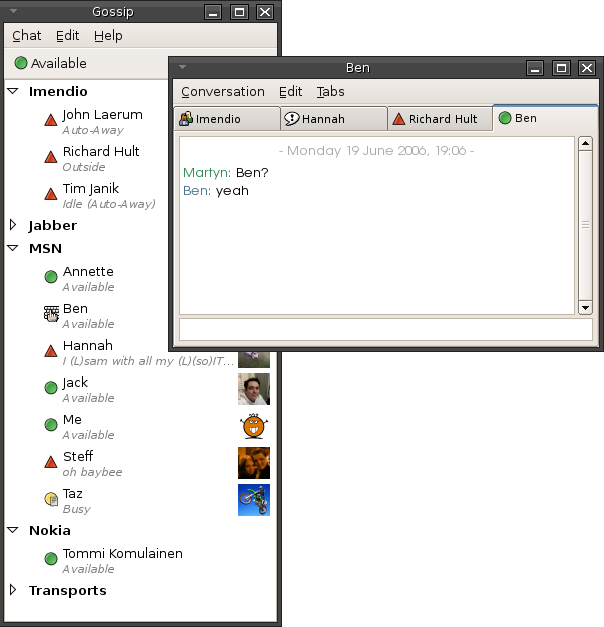|
BitNet
BITNET was a co-operative U.S. university computer network founded in 1981 by Ira Fuchs at the City University of New York (CUNY) and Greydon Freeman at Yale University. The first network link was between CUNY and Yale. The name BITNET originally meant "Because It's There Network", but it eventually came to mean "Because It's Time Network". A college or university wishing to join BITNET was required to lease a data circuit (phone line) from a site to an existing BITNET node, buy modems for each end of the data circuit, sending one to the connecting point site, and allow other institutions to connect to its site free of charge. Technical details Bitnet, with Remote Spooling Communications Subsystem (RSCS) and the Network Job Entry (NJE) network protocol, was used for the huge IBM internal network known as VNET. BITNET links originally ran at 9600 bit/s. The BITNET protocols were eventually ported to non-IBM mainframe operating systems, and became particularly widely i ... [...More Info...] [...Related Items...] OR: [Wikipedia] [Google] [Baidu] |
United States
The United States of America (U.S.A. or USA), commonly known as the United States (U.S. or US) or America, is a country primarily located in North America. It consists of 50 U.S. state, states, a Washington, D.C., federal district, five major unincorporated territories, nine United States Minor Outlying Islands, Minor Outlying Islands, and 326 Indian reservations. The United States is also in Compact of Free Association, free association with three Oceania, Pacific Island Sovereign state, sovereign states: the Federated States of Micronesia, the Marshall Islands, and the Palau, Republic of Palau. It is the world's List of countries and dependencies by area, third-largest country by both land and total area. It shares land borders Canada–United States border, with Canada to its north and Mexico–United States border, with Mexico to its south and has maritime borders with the Bahamas, Cuba, Russia, and other nations. With a population of over 333 million, it is the List of ... [...More Info...] [...Related Items...] OR: [Wikipedia] [Google] [Baidu] |
LISTSERV
The term Listserv (styled by the registered trademark licensee, L-Soft International, Inc., as LISTSERV) has been used to refer to electronic mailing list software applications in general, but is more properly applied to a few early instances of such software, which allows a sender to send one email Electronic mail (email or e-mail) is a method of exchanging messages ("mail") between people using electronic devices. Email was thus conceived as the electronic ( digital) version of, or counterpart to, mail, at a time when "mail" mean ... to a list, which then transparently sends it on to the addresses of the subscribers to the list. The original Listserv software, the Bitnic Listserv (also known as BITNIC LISTSERV) (1984–1986), allowed mailing lists to be implemented on IBM VM mainframes and was developed by Ira Fuchs, Daniel Oberst, and Ricky Hernandez in 1984. This mailing list service was known as Listserv@Bitnic (also known as LISTSERV@BITNIC) and quickly beca ... [...More Info...] [...Related Items...] OR: [Wikipedia] [Google] [Baidu] |
UUCPNET
UUCP is an acronym of Unix-to-Unix Copy. The term generally refers to a suite of computer programs and protocols allowing remote execution of commands and transfer of files, email and netnews between computers. A command named is one of the programs in the suite; it provides a user interface for requesting file copy operations. The UUCP suite also includes (user interface for remote command execution), (the communication program that performs the file transfers), (reports statistics on recent activity), (execute commands sent from remote machines), and (reports the UUCP name of the local system). Some versions of the suite include / (convert 8-bit binary files to 7-bit text format and vice versa). Although UUCP was originally developed on Unix in the 1970s and 1980s, and is most closely associated with Unix-like systems, UUCP implementations exist for several non-Unix-like operating systems, including DOS, OS/2, OpenVMS (for VAX hardware only), AmigaOS, classic Mac OS ... [...More Info...] [...Related Items...] OR: [Wikipedia] [Google] [Baidu] |
Store And Forward
Store and forward is a telecommunications technique in which information is sent to an intermediate station where it is kept and sent at a later time to the final destination or to another intermediate station. The intermediate station, or node in a networking context, verifies the integrity of the message before forwarding it. In general, this technique is used in networks with intermittent connectivity, especially in the wilderness or environments requiring high mobility. It may also be preferable in situations when there are long delays in transmission and variable and high error rates, or if a direct, end-to-end connection is not available. Modern store and forward networking * Store and forward originates with delay-tolerant networks. No real-time services are available for these kinds of networks. * Logistical Networking is a scalable form of store and forward networking that exposes network-embedded buffers on intermediate nodes and allows flexible creation of services b ... [...More Info...] [...Related Items...] OR: [Wikipedia] [Google] [Baidu] |
Point-to-point (telecommunications)
In telecommunications, a point-to-point connection refers to a communications connection between two communication endpoints or nodes. An example is a telephone call, in which one telephone is connected with one other, and what is said by one caller can only be heard by the other. This is contrasted with a '' point-to-multipoint'' or ''broadcast'' connection, in which many nodes can receive information transmitted by one node. Other examples of point-to-point communications links are leased lines and microwave radio relay. The term is also used in computer networking and computer architecture to refer to a wire or other connection that links only two computers or circuits, as opposed to other network topologies such as buses or crossbar switches which can connect many communications devices. ''Point-to-point'' is sometimes abbreviated as '' P2P''. This usage of ''P2P'' is distinct from ''P2P'' meaning ''peer-to-peer'' in the context of file sharing networks or other d ... [...More Info...] [...Related Items...] OR: [Wikipedia] [Google] [Baidu] |
Internet
The Internet (or internet) is the global system of interconnected computer networks that uses the Internet protocol suite (TCP/IP) to communicate between networks and devices. It is a ''internetworking, network of networks'' that consists of private, public, academic, business, and government networks of local to global scope, linked by a broad array of electronic, wireless, and optical networking technologies. The Internet carries a vast range of information resources and services, such as the inter-linked hypertext documents and Web application, applications of the World Wide Web (WWW), email, electronic mail, internet telephony, telephony, and file sharing. The origins of the Internet date back to the development of packet switching and research commissioned by the United States Department of Defense in the 1960s to enable time-sharing of computers. The primary precursor network, the ARPANET, initially served as a backbone for interconnection of regional academic and mi ... [...More Info...] [...Related Items...] OR: [Wikipedia] [Google] [Baidu] |
Instant Messaging
Instant messaging (IM) technology is a type of online chat allowing real-time text transmission over the Internet or another computer network. Messages are typically transmitted between two or more parties, when each user inputs text and triggers a transmission to the recipient(s), who are all connected on a common network. It differs from email in that conversations over instant messaging happen in real-time (hence "instant"). Most modern IM application (computing), applications (sometimes called "social messengers", "messaging apps" or "chat apps") use push technology and also add other features such as emojis (or graphical smileys), file transfer, chatbots, voice over IP, or Videotelephony, video chat capabilities. Instant messaging systems tend to facilitate connections between specified known users (often using a contact list also known as a "buddy list" or "friend list"), and can be standalone applications or integrated into e.g. a wider social media platform, or a website ... [...More Info...] [...Related Items...] OR: [Wikipedia] [Google] [Baidu] |
Uuencoding
uuencoding is a form of binary-to-text encoding that originated in the Unix programs uuencode and uudecode written by Mary Ann Horton at UC Berkeley in 1980, for encoding binary data for transmission in email systems. The name "uuencoding" is derived from Unix-to-Unix Copy, i.e. "Unix-to-Unix encoding" is a safe encoding for the transfer of arbitrary files from one Unix system to another Unix system but without guarantee that the intervening links would all be Unix systems. Since an email message might be forwarded through or to computers with different character sets or through transports which are not 8-bit clean, or handled by programs that are not 8-bit clean, forwarding a binary file via email might cause it to be corrupted. By encoding such data into a character subset common to most character sets, the encoded form of such data files was unlikely to be "translated" or corrupted, and would thus arrive intact and unchanged at the destination. The program uudecode reverses the ... [...More Info...] [...Related Items...] OR: [Wikipedia] [Google] [Baidu] |
TRICKLE
''Trickle'' is the second and most recent album from English trip hop band Olive. History Following the band's debut album '' Extra Virgin'' and a subsequent promotional tour, keyboard programmer Robin Taylor-Firth left the band. Also during this time the UK arm of record label RCA lost interest in supporting the band; as a result, Olive was dropped from the RCA roster. By this time, the follow-up album had been completed, including a cover of the 1975 UK number-one single " I'm Not in Love" by 10cc (chosen partially as an attempt to obtain better favour with RCA). However, Olive then signed with Maverick Records, after reportedly being discovered by label founder Madonna when she attended one of their concerts in Germany; initially, the band were recruited for a contribution to the soundtrack to the Madonna film ''The Next Best Thing'', and a recording contract resulted from the contact. "I'm Not in Love" became the band's contribution to the February 2000-released soun ... [...More Info...] [...Related Items...] OR: [Wikipedia] [Google] [Baidu] |
CRC Press
The CRC Press, LLC is an American publishing group that specializes in producing technical books. Many of their books relate to engineering, science and mathematics. Their scope also includes books on business, forensics and information technology. CRC Press is now a division of Taylor & Francis, itself a subsidiary of Informa. History The CRC Press was founded as the Chemical Rubber Company (CRC) in 1903 by brothers Arthur, Leo and Emanuel Friedman in Cleveland, Ohio, based on an earlier enterprise by Arthur, who had begun selling rubber laboratory aprons in 1900. The company gradually expanded to include sales of laboratory equipment to chemists. In 1913 the CRC offered a short (116-page) manual called the ''Rubber Handbook'' as an incentive for any purchase of a dozen aprons. Since then the ''Rubber Handbook'' has evolved into the CRC's flagship book, the ''CRC Handbook of Chemistry and Physics''. In 1964, Chemical Rubber decided to focus on its publishing ventures ... [...More Info...] [...Related Items...] OR: [Wikipedia] [Google] [Baidu] |
Usenet
Usenet () is a worldwide distributed discussion system available on computers. It was developed from the general-purpose Unix-to-Unix Copy (UUCP) dial-up network architecture. Tom Truscott and Jim Ellis conceived the idea in 1979, and it was established in 1980.''From Usenet to CoWebs: interacting with social information spaces'', Christopher Lueg, Danyel Fisher, Springer (2003), , Users read and post messages (called ''articles'' or ''posts'', and collectively termed ''news'') to one or more topic categories, known as newsgroups. Usenet resembles a bulletin board system (BBS) in many respects and is the precursor to the Internet forums that have become widely used. Discussions are threaded, as with web forums and BBSs, though posts are stored on the server sequentially.The jargon file v4.4.7 , Jargon File Archive. [...More Info...] [...Related Items...] OR: [Wikipedia] [Google] [Baidu] |



